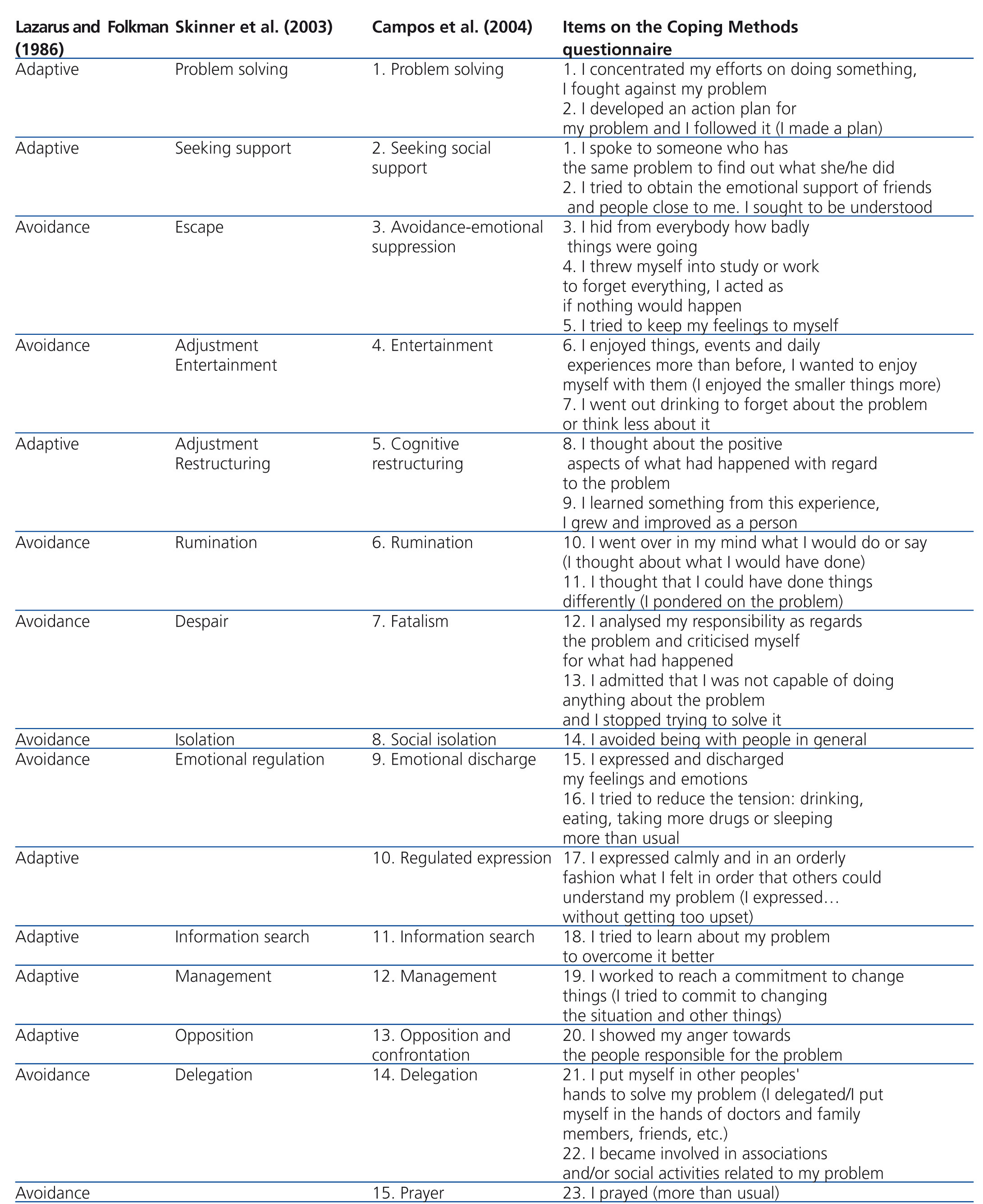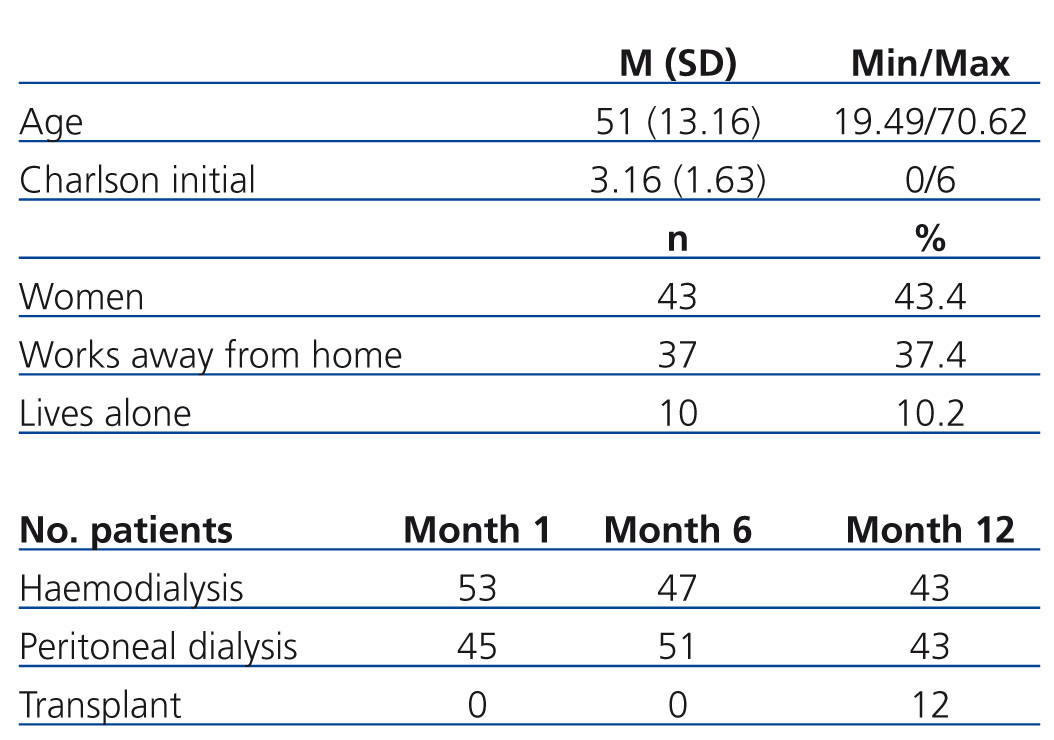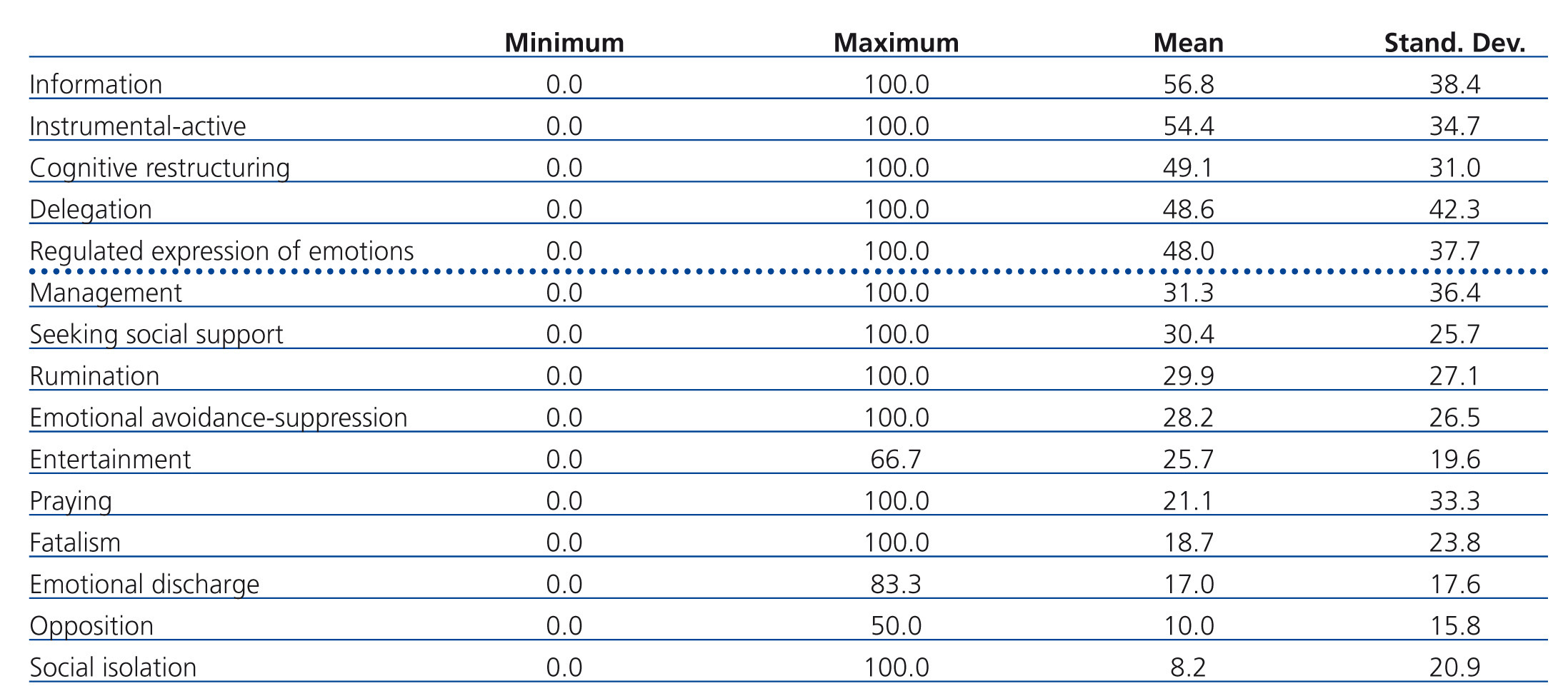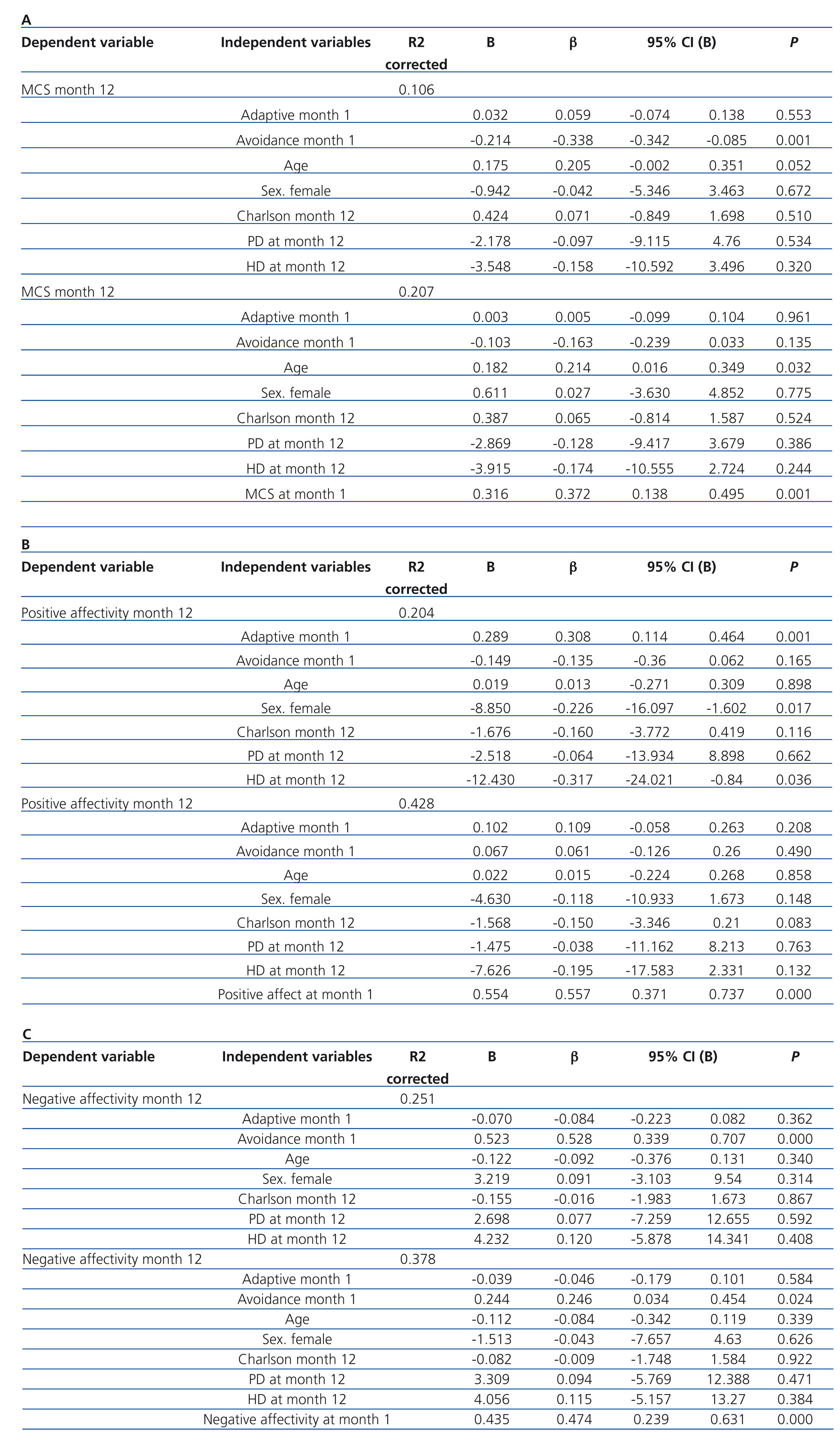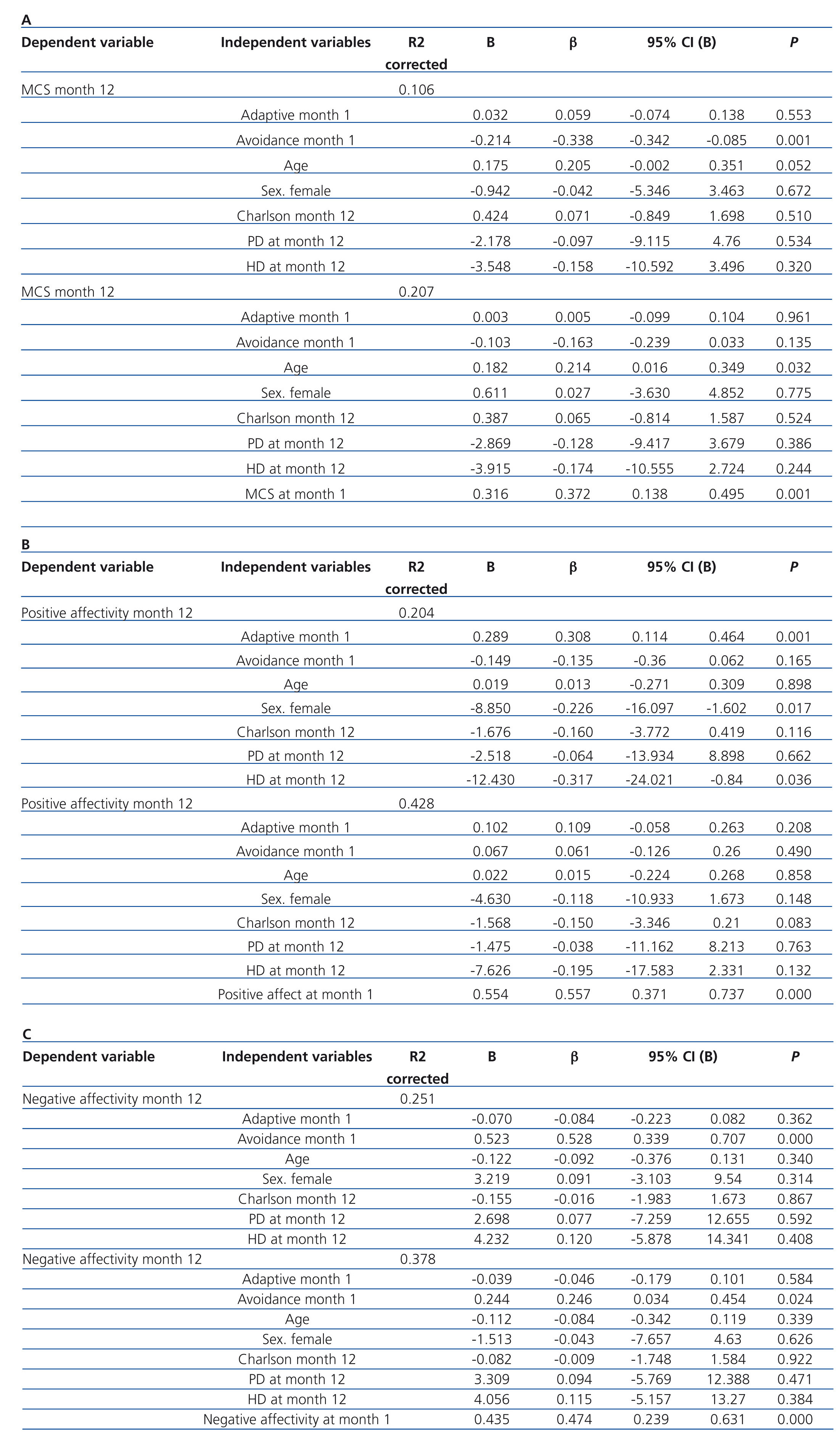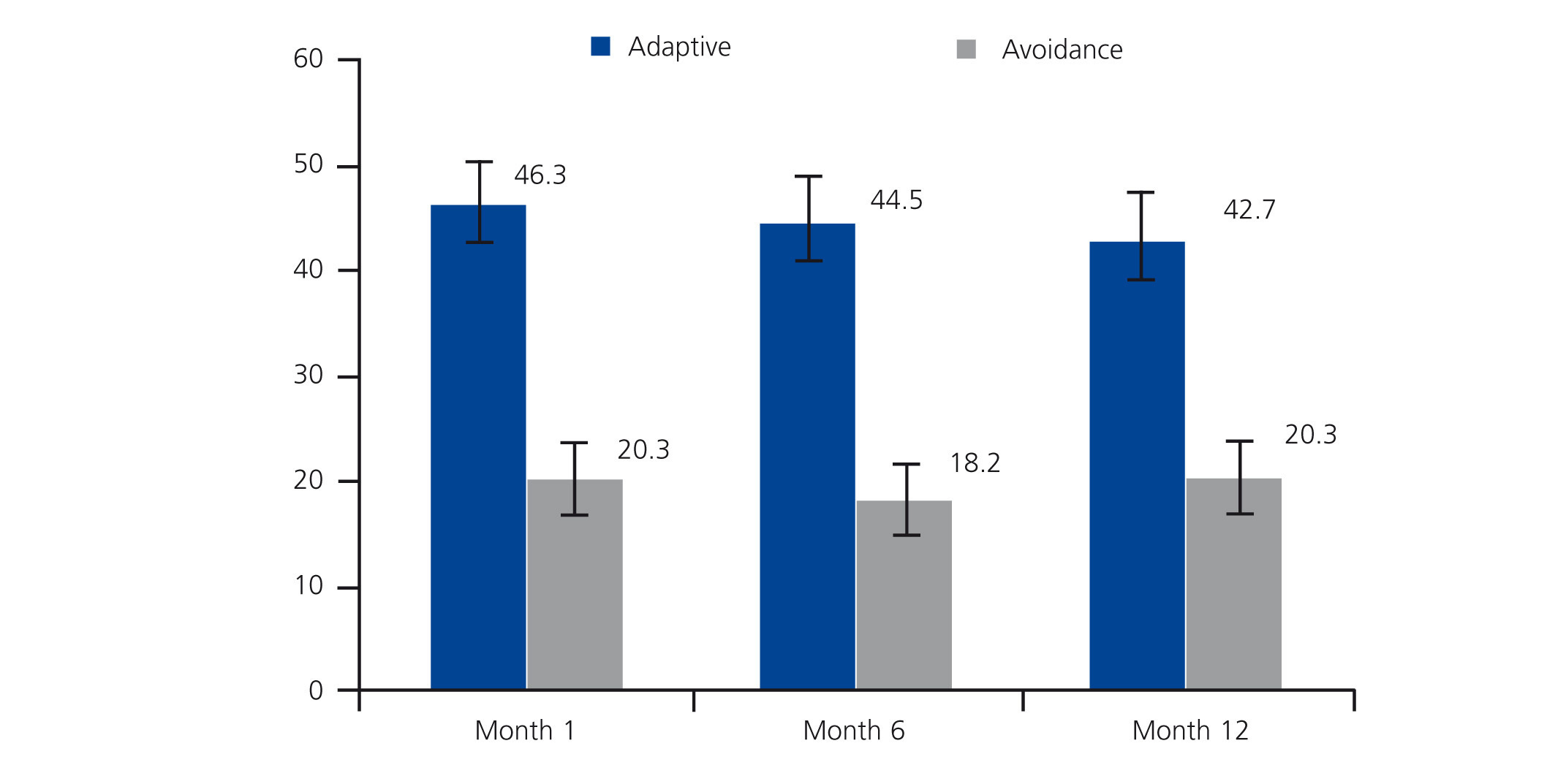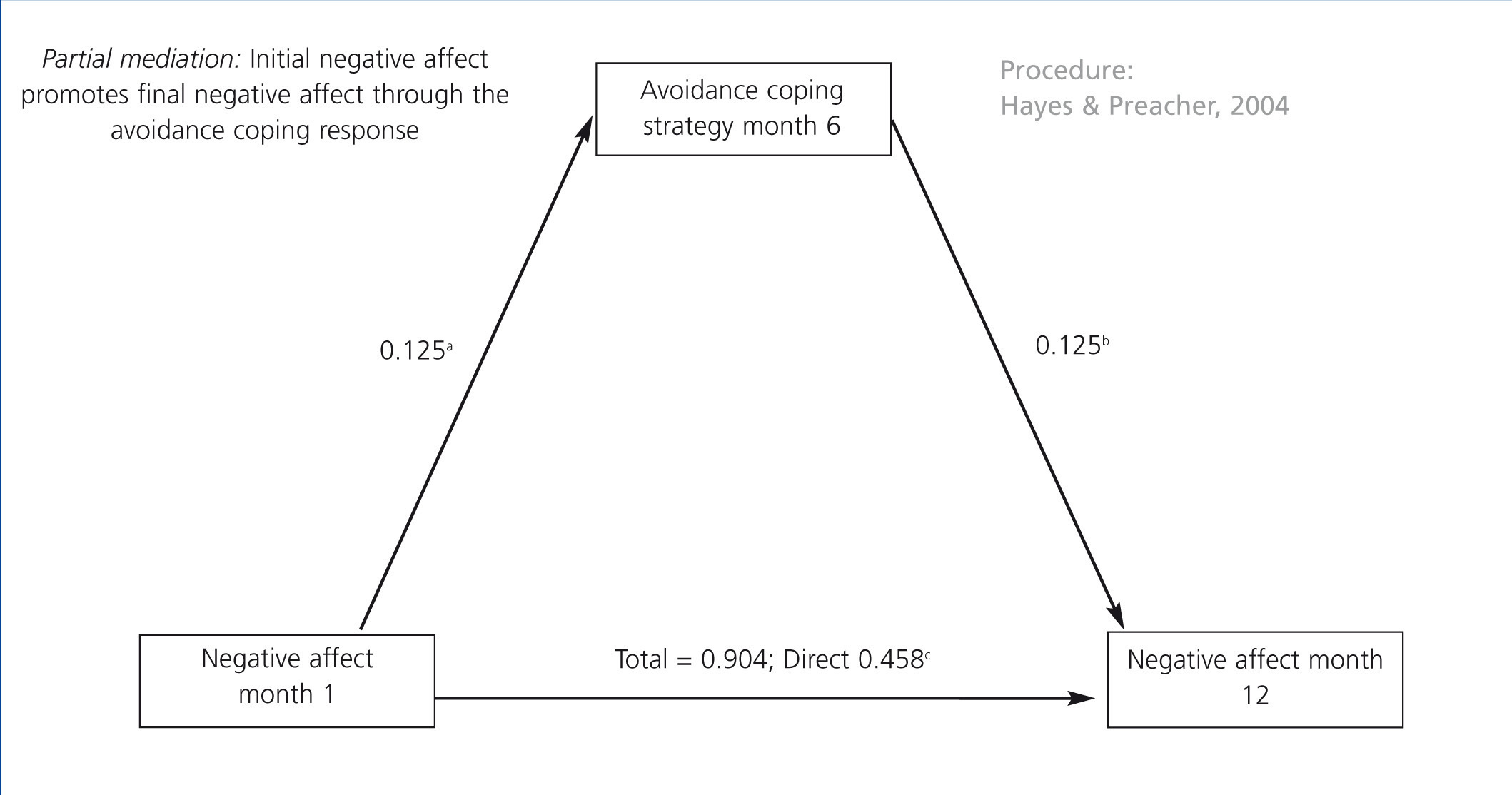Introducción: Ante el impacto negativo que supone el inicio de la diálisis, es necesario identificar factores psicológicos que afecten a la calidad de vida y salud emocional. Objetivos: Conocer las formas de afrontamiento más utilizadas a lo largo del primer año de tratamiento y analizar su influencia en la calidad de vida y salud emocional. Material y métodos: Estudio longitudinal sobre 98 pacientes incidentes en hemodiálisis y diálisis peritoneal. Se realizaron entrevistas al mes, a los 6 y los 12 meses del inicio de la diálisis, para completar cuestionarios: MOS-SF36, PNA (afectividad) y Formas de Afrontamiento. Resultados: El tipo de estrategias más usadas fueron la Búsqueda de información, Resolución de problemas, Reestructuración cognitiva, Delegación y Expresión regulada de las emociones (p < 0,001). Los afrontamientos de Aproximación se utilizaron más que los de Evitación (p < 0,01); estas diferencias no se modificaron a lo largo del tiempo. La Evitación al inicio fue predictora de mayor afectividad negativa (p < 0,001) y peor componente mental de MOS-SF36 al cabo de un año (p < 0,001). La Evitación a los 6 meses moduló la relación entre afecto negativo al primer mes y al año (p < 0,01). La Aproximación en el primer mes fue predictora de afectividad positiva al cabo de un año (p < 0,001). Conclusiones: Las estrategias de Evitación y Aproximación son factores que influyen en el bienestar psicológico de los pacientes en diálisis. Los pacientes que utilizan estrategias de Evitación al inicio de diálisis están a riesgo de empeorar su bienestar psicológico. Es importante para los profesionales identificar precozmente las estrategias de Evitación.
Introduction: Given the negative impacts of dialysis, we must assess and comprehend the psychological factors that affect quality of life and emotional health in dialysis patients. Objectives: We sought to evaluate the most commonly used coping mechanisms during the first year of treatment and to analyse the influence of these strategies on quality of life and emotional health. Material and Method: Longitudinal study of 98 incident patients on haemodialysis and peritoneal dialysis. We interviewed patients at 1, 6, and 12 months after starting dialysis using the MOS-SF36, PNA (affectivity), and Coping Strategies questionnaires. Results: The most commonly used strategies were Information search, Problem solving, Cognitive restructuring, Delegation, and Regulated expression of emotions (P<.001). Adaptive coping strategies were used more frequently than Avoidance coping strategies (P<.01); these differences did not vary over time. Initially, Avoidance was a predictor for a stronger negative emotion (P<.001) and a worse score for the mental component of the MOS-SF36 survey after one year (P<.001). At 6 months, avoidance modulated the relationship between negative emotions after one month and one year (P<.01). Adaptive coping during the first month was a predictor for positive emotion at the end of one year (P<.001). Conclusions: Avoidance and Adaptive mechanisms are coping strategies that influence the psychological well-being of patients on dialysis. Patients who use Avoidance strategies at the start of dialysis are at risk for worsening their psychological state of health. It is important for health care professionals to be able to identify Avoidance strategies at an early stage of dialysis treatment.
INTRODUCTION
Dialysis imposes physical, psychological and social changes that require adaptation to a new way of life, and as such, an individual must self-regulate their emotional state to deal with this new adverse situation. It is well-known that people on dialysis have a high incidences of anxiety and depression,1,2 live with a high level of stress3,4 and have a worse perception of the quality of life.5,6
Although health-related quality of life (HRQOL) has been considered a good indicator of physical and psychological well-being in chronic illness7 and also a strong predictor of morbidity8 and mortality,9,10 this measure has its limitations, and as such, its use is recommended in conjunction with other indicators.11 In this sense, the concept of quality of life is more extensive and covers psychological well-being, containing the cognitive component that refers to the overall state of satisfaction and the affective component, described as the emotions experienced that provide information about how life is.12,13 The affective component of psychological well-being includes the positive emotional state (for example: happiness, affection, enjoyment, interests) known as the positive affect and the negative emotional state (anger, sadness, anxiety, worry, guilt) used to designate the negative affect.14 For most people, the affect balance is positive, however in patients with serious illnesses the positive affect may be lower, although it is never absent.15
Increasingly more data highlight that physical variables are insufficient for understanding the impact of dialysis on the quality of life and this leads us to explore psychological11 and social variables that allow new quality of life modulators to be identified, such as coping.16
Coping with chronic illness is the self-regulating process that patients carry out when faced with adversity, with self-regulation being considered as the efforts of individuals to create or maintain the conditions desired in their lives.17 Coping can be considered to be a “style” or a “strategy”. The coping style is a stable predisposition in adverse situations; it is characterised as consistent and is determined by the personality of each individual. However, strategies are characterised as changeable in accordance with the triggering conditions.18 The main coping strategy classifications are the adaptive and avoidance coping strategies.19 In the adaptive coping strategy, the responses are oriented towards active acts of vigilance, attention to the problem and management of negative emotions. In the avoidance coping strategy, acts are passive in order that a person may distance from the threat. This includes acts of abandonment and poor management of negative emotions. These two main categories are in turn divided into subcategories that describe more specific responses.20
Adaptive strategies have been associated with decreased stress levels21 and greater positive affectivity,22 while avoidance strategies have been associated with lower survival rates.23
In the field of chronic kidney disease renal replacement therapy, some cross-sectional studies have related the coping types with the quality of life16,24 or affectivity.22
However, coping strategies may be altered and may change over time.25 In previous cross-sectional studies on prevalent patients, significant associations were found between time on dialysis and quality of life and coping types.26 We consider it necessary to carry out longitudinal studies that add information about strategies in order to design treatment that results in an improved perception of the quality of life.
This study aims to analyse the impact of the ways of coping with dialysis on the quality of life and emotional health. Firstly, the most commonly used coping strategies of patients in the first year of replacement therapy are described; secondly, we will measure the impact of coping on the quality of life and the emotional state (affectivity).
MATERIAL AND METHOD
Patients
This longitudinal study was carried out on patients who began renal replacement therapy through peritoneal dialysis (PD) or ambulatory haemodialysis (HD) in nine nephrology units of the Basque Autonomous Community: Hospital de Txagorritxu and Hospital de Santiago of Vitoria, Hospital de Galdakao, Hospital de Cruces, Hospital de Basurto, Clínica Virgen Blanca and Centro Dialbilbo of Bizkaia, and Hospital de Donostia and Policlínica de Gipuzkoa, of Gipuzkoa. It covered the public network and the outpatient network of all centres in the Basque Autonomous Community. 85% of these patients were followed in nephrology outpatient services for a period of over six months prior to commencing dialysis. During the period between 1 October 2006 and 31 January 2008, 333 patients began dialysis in the Basque Autonomous Community. Patients who met the following criteria were selected: a) age of between 18 and 70 years old, b) a physical, mental and linguistic capacity to answer the questions of the questionnaire, in accordance with the criteria of the interviewing nurse, c) provision of informed consent. The following were excluded: 170 patients above 70 years of age, 13 due to serious illness, 9 due to a mental disorder, 14 due to lack of comprehension of the questionnaire and 17 patients did not wish to participate in the study. Of the 110 patients selected, 12 did not complete the follow up proposed, 6 due to death and 6 due to voluntary withdrawal. Therefore, the sample included 98 patients who answered the questionnaire in the three stages of the study. Twelve patients received transplants after between 6 and 12 months; said patients were not excluded from the analysis, however, the analyses carried out were adjusted in accordance with the method of treatment.
INSTRUMENTS AND MEASUREMENTS
In the first interview, the following variables were recorded: age, sex, date of the first visit to the nephrology outpatient service, date and initial method of renal replacement therapy. It included whether or not they were on the kidney transplant waiting list and the question “Do you hope to receive a kidney transplant” was asked, since hope may alter the type of coping used. Furthermore, in each interview, the following was recorded: Charlson index27 and method of treatment and the following instruments were applied:
Ways of Coping Scale-25
To determine how people cope with the repercussions of dialysis and their circumstances, we used the Ways of Coping and Dimensions instrument20 based on Lazarus and Folkman’s Ways of Coping (WOC-R),28 and the revision by Skinner et al.19 This scale consists of two basic dimensions (adaptive versus avoidance) and 15 coping families.
To determine how people cope with the repercussions of dialysis and their circumstances, we used the Ways of Coping and Dimensions instrument.20 This scale consists of 15 coping dimensions: Problem solving, Seeking social support, Emotional avoidance-suppression, Distraction, Cognitive restructuring, Rumination, Fatalism, Social isolation, Emotional discharge, Regulated expression of emotions, Information search, Management, Opposition and confrontation, Delegation and Prayer, organised into 25 items with a response range of 1 = not at all to 4 = a lot (Table 1). This instrument was applied to the general population and patients with infection caused by the human immunodeficiency virus in Spain and Latin America and it demonstrated predictive validity for positive and negative affectivity.20 In the sample of this study, Cronbach’s alpha internal consistency coefficients were 0.74 for the adaptive coping strategy and 0.65 for avoidance.
Health-related quality of life(MOS-SF36)
HRQOL was measured by the Medical Outcomes Study Short Form (MOS-SF36) instrument29 with 36 items that covered two areas, physical component change (PCS) and emotional component change (MCS). The items and dimensions of the MOS-SF36 are scored in such a way that the higher the score the better the health result is. For each dimension, the items are encoded, added and transformed into a scale whose lowest value is 0 (the worst state of health for this dimension) and whose highest value is 100 (the best state of health). In this study, internal consistency, estimated by Cronbach’s MOS-SF36 alpha coefficient was 0.85 for PCS and 0.85 for MCS.
PNA Scale
The Positive and Negative Affect (PNA) scale was applied to measure affectivity in the four weeks before filling in the questionnaire. This scale was adapted for a Spanish context and into the Spanish language30 and was applied to other studies in various populations.31 This study includes 18 items, 9 measure the positive affect and the other 9 the negative affect, with a response format of 1 = never to 4 = always. The positive affect items include the emotional state of joy, satisfaction and enjoyment. The negative affect items include emotions related to stress, with fight or flight reactions, and emotions of fatigue, worry, boredom and fear. In this study Cronbach’s alpha was 0.78 for the positive affect and 0.68 for the negative affect.
PROCEDURE
After obtaining the corresponding permission from the research units and ethics committee, a nurse was selected for each dialysis unit. The nine nurses were trained at the same time with the aim of ensuring homogeneity in the procedure criteria. During the months in which the data was collected, six coordination meetings were held. The interviewing nurse explained to and requested from the patients their consent to participate in the study. The questionnaires were applied to both sexes, and the questions were read by the patients with the help of the nurse. Patients filled in the questionnaires 30 days after beginning dialysis in a stable situation; that is to say, when they were carrying out routine activities and living at home. The second and third evaluations were carried out after six days and twelve months respectively. Patients on hospital haemodialysis (HHD) completed the questionnaires during or after the session and those on continuous ambulatory PD completed the questionnaire during the visit to the check-up service. During the interview, the interviewing nurse accompanied the patient, answered their questions and adjusted the questionnaires in accordance with the state and desire of the patient. The questionnaires were completed just once in 90% of cases and the mean completion time fluctuated between 20 and 160 minutes, with a mean of 51 minutes.
Statistical analysis
Descriptive statistics were used to summarise the results of each variable. The scores obtained by the instruments used were treated as continuous variables; ordinary descriptive measurements, mean and standard deviation were used for continuous variables and percentages were used for categorical variables. The original scores of the PNA and Ways of Coping scales were transformed to a scale of 0 to 100 to homogenise them with the format of the quality of life (MOS-SF36) scale.
We used factor scores resulting from an exploratory analysis (principal components, Varimax rotation), which grouped the different items into two types of coping strategy dimensions (adaptive versus avoidance). To know if a coping strategy dimension was used more than another in the first visit, the Student’s t test was used for paired data.
ANCOVA was used for repeated measurements and adjusted for age, sex and comorbidity (Charlson), with the aim of testing if there were changes over time in the different strategies analysed. Multiple linear regression was applied to estimate the association between different variables and adjust for covariates such as age, sex, Charlson index and method of treatment, with all these variables being included in just one step. To include the treatment method, two dummy variables were created: HD and PD and as such, the transplant patient group was used as a reference group with respect to the PD and HD groups. To test the indirect mediation effects of coping on affectivity, the mediation effect was estimated by the bootstrap procedure defined by Hayes.32
If the value calculated for P was below .05, the difference was considered to be statistically significant. The SPSS statistical package, version 17.0 for Windows XP was used, with the corresponding macros for carrying out the mediation test created by Hayes.33
RESULTS
Table 2 displays the mean values of age and the frequencies of demographic and social-labour variables, as well as the changes in the method of treatment over time. Only 33% of patients were included as active in the kidney transplant waiting list. 96% of patients answered “yes” to the question “Do you hope to receive a kidney transplant?”
To group the different coping strategies, the exploratory factor analysis of principal components with Varimax rotation was used. For the results of the questionnaire of coping over time 1, this analysis displayed two types of categories of coping strategies: a) an adaptive coping strategy that included items 1, 2, 4, 8, 10, 11, 12, 20 and 21 and b) avoidance, including items 5, 7, 13, 14, 16 and 22 of the Ways of Coping and Dimensions questionnaire (Table 1), whose percentages of explained variance were 17% for adaptive and 12% for avoidance. There were no significant changes over time either in the adaptive group, P=.53, or the avoidance group, P=.61; ANCOVA was used for repeated measurements and age, sex and Charlson were monitored. The adaptive coping strategy score was significantly higher than that of avoidance in the three visits: 1 month, 6 months and 1 year; P<.01 for the three comparisons by the Student’s paired t-test (Figure 1).
With the aim of discovering the strategies that were most used by patients, we selected the results of the first evaluation in the first month of treatment, we ordered from highest to lowest the scores of the 15 coping strategy dimensions and we took a value of 33.3, corresponding to score 2 (when the question is answered with “sometimes”) as the criterion for considering those that were most used. The coping dimensions with a score above 33.3 were: Information search, Problem solving, Cognitive restructuring, Delegation and Regulated expression of emotions; the mean score was obviously below 33.3 in the other dimensions. Subsequently, we compared the mean scores of those with a mean score above 33.3 with those with a mean score below 33.3. The comparisons of the means by the Student’s paired t-test revealed statistically significant differences for all comparisons made, P<.001 (Table 3).
To test the prediction capacity of adaptive and avoidance coping strategies on the MCS and PCS of MOS-SF36, we used multiple regression models in which the dependent variable was MCS and PCS at month 12 and the independent variables were the adaptive and avoidance coping strategies at month 1; we included Charlson comorbidity, age, sex and the treatment method at month 12 as covariate adjustments. For analysis of multiple linear regression using MCS at month 12 as a dependent variable, we did not find a significant predictive value for adaptive coping, but we did for avoidance coping, P=.001. After adding MCS at month 1 as a covariate, the significance of the avoidance coping strategy was lost, P=.135 (Table 4a). In the multiple linear regression analysis using PCS at month 12 as a dependent variable, we did not find a significant predictive value for adaptive coping or avoidance coping (results not displayed).
To test if the adaptive and avoidance coping strategies were predictors of positive affectivity, multiple regression models were also used in those in which the dependent variable was positive affectivity at month 12 and the independent variables were the adaptive and avoidance coping strategies at month 1. We also included Charlson, age, sex and treatment method at month 12 as covariate adjustments. We observed a significant predictive value for adaptive coping (P=.001); however, we found no significance for the avoidance coping strategy in month 1. After adding positive affectivity at month 1 as a covariate, the adaptive coping significance was lost (Table 4b).
To evaluate the prediction capacity of the same coping strategies on negative affectivity, similar models were used, in which the dependent variable was the aforementioned negative affectivity in month 12. A positive and significant predictive effect was observed for the avoidance coping strategy, P<.001. In this case, when it was adjusted for negative affectivity at month 1, the significant effect was maintained for the avoidance coping strategy at month 1 on negative affectivity at month 12, P=.024. The adaptive coping strategy at month 1 did not show a significant effect (Table 4c).
We analysed the changes over time of the Charlson index, the MCS and the PCS, as well as positive and negative affectivity comparing the means at the three visits, 1, 6 and 12 months by ANOVA for repeated measurements, considering only the linear model. The Charlson index and negative affectivity showed changes, with a statistically significant increase of the first, P<.001 and a linear decrease over time of negative affectivity, P=.023 (Table 5) being observed.
The mediation effect of the avoidance coping strategy was contrasted at six months on the relationship of the negative effect at month 1 and the same negative effect at month 12. A significant mediation effect was found for the avoidance coping strategy, and as such the relationship between initial affectivity and affectivity at the end of a year is measured by the avoidance responses that increase the negative effect (Figure 2).
DISCUSSION
Evolution in coping strategies
The participants of this study more frequently use adaptive than avoidance coping strategies, as was noted in previous studies on patients on dialysis34-36 and patients with cancer.37 Furthermore, in this longitudinal study, we observed that during the first twelve months of treatment, the use of adaptive and avoidance coping strategies remained stable. These findings contrast with results in a meta-analysis carried out in other types of stressful situations in which avoidance strategies decreased after initial contact with the stressor.38
The lack of longitudinal studies on coping in patients on dialysis prevents comparisons from being made; however, several hypotheses may explain that coping strategies remain constant during the first year.
It is known that the adaptive strategies have been associated with controllable situations in which the person perceives that they have an ability to manage the situation. For participants in this study, starting dialysis is not an unexpected situation, most have time to know, imagine what it would be like to live on dialysis and prepare themselves for beginning treatment. As such, in the sample, 85% of patients were monitored in nephrology outpatient services for over six months prior to dialysis. Furthermore, the adaptive-fighter coping strategy was negatively related with despair.24 96% of patients hoped to receive a transplant; however, only 33% of them were included on the waiting list. This hope sustains patients’ optimism about recovering from the situation that they had prior to dialysis; as such, they could minimise the stress generated by the negative consequences of dialysis, given that it is perceived as something temporary. Both affirmations may mean that the impact of dialysis does not cause such a high level of stress that major avoidance and flight responses are created.
There is evidence that the physical symptoms and other stress factors are associated with avoidance coping strategies.39 In this study, no clinically significant variations were observed in the Charlson comorbidity index or in the physical component of the MOS-SF36, owing to the fact that inclusion criteria contributed to the selection of patients with low comorbidity, and as such there was no intense physical deterioration which could have caused increased avoidance responses.
Overall, there were no changes in the use of adaptive or avoidance strategies over one year. It was expected that the coping strategies would change depending on the time passed from the start of treatment, as had been affirmed in other stressful situations40 and as was observed in the previous cross-sectional study carried out on prevalent patients from the same region, where it was shown on a correlational level that the more time on dialysis, the more the stress levels increased and the more patients showed isolation, got angry and the less they enjoyed things.26
When we coordinate the specific forms of coping, the adaptive strategies most used by these patients were, firstly, Information search, followed by Problem solving and Cognitive restructuring. If we compare this information with people treated with chemotherapy, we found some differences: although the measurement instrument was not the same, conversely Cognitive restructuring was used firstly, followed by Problem solving.37 Restructuring, re-evaluating and establishing new priorities in life is a common response to intense traumatic situations that call into question the assumptions about vital daily functioning. It is in these extreme circumstances that people “think about what is really important in life” and throw themselves into family relationships, which changes their priorities.41 When we compare kidney disease and cancer, if cancer patients consent to receiving chemotherapy, they cannot deny the situation but neither can they change it, and as such, they have to focus their efforts on reinterpreting, searching for and finding positive aspects about their life; patients on dialysis in this first stage of treatment can focus on managing the situation, searching for information to reorganise their lives when faced with the changes that accompany dialysis.
Impact of coping strategies on quality of life
In this study, we did not observe that the use of adaptive coping strategies had a predictive effect on the MCS of the HRQOL; however, a recent cross-sectional study found that active coping predicts an increase in HRQOL.42
Nevertheless, avoidance strategies are predictors of worse MCS. Previous studies also showed these relationships in patients on dialysis8,16,42,43 and patients on chemotherapy37, indicating that the avoidance coping strategy is associated with an increase in symptoms of depression.
This predictive effect was lost when we adjusted the MCS measured at month 1. This can be explained by the strong correlation that existed between the mean MCS at the beginning of the year and at the end of the year, given that patients hardly changed their perception of the MCS throughout the study. Nevertheless, it is likely that there is a predictive capacity of avoidance on HRQOL, but perhaps it would have been necessary to wait more time in order for more changes in the MCS to occur throughout follow-up, given that, in a cross-sectional study on prevalent patients with a longer time on dialysis, an association between a low score for MCS and the time on dialysis was displayed.26 Another explanation is that the lack of significance in the MCS adjusted model at the beginning may be due to the small sample size.
People simultaneously experience positive and negative affectivity. In these patients, positive affects carry more weight that negative affects, as is normal for most people whose emotional balance is usually slightly positive; therefore, this positive balance is interpreted as an adaptive response of people to facing the tasks and demands of daily life.30 With longitudinal data, it has been shown for different age groups that the positive affect is always greater than the negative affect in spite of positive effects decreasing slightly with increased age.13 The positive affectivity scores did not suffer major changes in the first twelve months, unlike other affirmations that signal that in initial stressful stages, positive affectivity may decrease.15 Therefore, in these participants, manifestations of joy, happiness from friendship, showing interest in things, feeling energy and having certain hopes for the future neither increased or decreased significantly during the first year of treatment. On the other hand, we observed a trend of decreased negative affectivity over time, indicating that these patients feel less worried, with less desire to cry and are less bored at the end of the first year than at the start of treatment.
We also found a predictive effect of adaptive coping on positive affectivity. That is, the adaptive coping responses in the items: “I worked to change things”, “I enjoy things more”, “I developed an action plan/I concentrated my efforts on fighting”, “I thought about what I would do”, “I thought about and emphasised the positive aspects”, “I tried to find out information”, “I tried to obtain the support of my friends” were related in dialysis patients with emotional states of joy, motivation, interest, energy and hope. These associations were also found in other studies of people in non-illness circumstances22 and with patients with myocardial infarction44, but contrarily, no negative association between adaptive coping with the negative affect was detected as in other studies.22 Nevertheless, an avoidance effect was found, which concurs with the difference between affects: the negative affect was linked to reactions of stress, anxiety and threats; on the contrary, the positive affect was linked to support and rewards30. In the analyses carried out, the link between adaptive coping at the start and positive affectivity at month 12 is also lost upon adjusting for positive affectivity at month 1. The same happens as with the MCS: over twelve months no changes occurred in the positive affectivity if we compare its mean values, therefore perhaps with a longer follow-up period, the association would have been maintained after the adjustment.
It is important to highlight that when the same analyses are applied to the avoidance coping strategies, the predictive effect of avoidance on negative affectivity remains significant although it is adjusted for negative affectivity at month 1. Therefore, we can say that the changes produced in negative affectivity depend on the avoidance coping strategy that is used at the start of treatment. That is to say that the patients who have coping responses of the following types at the start of treatment: Isolation: “I avoided being with people”, Emotional suppression: “I hid from others how badly things were going for me”, “I tried to keep my feelings to myself”, Rumination: “I thought about how things could have been”, Blaming oneself: “I analysed my responsibility for the problem”, encourage emotional states of sadness, loss of motivation, worry, less control and less satisfaction. In the studies referenced above there was a relationship between the avoidance coping strategy and negative affectivity, but this was in cross-sectional designs that always ask the question about what the cause and consequences are. The contribution of this study is that it found this predictive association in a longitudinal study. The mediation effect of the avoidance coping strategy indicated that the relationship between negative affects at one month and one year was reduced by the mediation effect of coping strategies, indicating that avoidance affects the affective state at the end of the year.
The differences shown in relationships, on one hand of the adaptive coping strategy and the positive affect, and on the other, of the avoidance coping strategy and the negative affect are congruent with the neurobiological foundations of affectivity. Psychological theories propose that positive and negative affectivity constitute neurobiological components that have evolved to respond to different evolutionary tasks. As such, the negative affect is related to avoidance behaviour and inhibition of adaptive responses that maintain the organism outside situations of danger, pain or punishment. Nevertheless, positive affectivity is related to facilitating behaviour that orientate the organism towards the search for pleasure and support.45
Some meta-analyses emphasise the beneficial effects of adaptive coping strategies and the negative effects of avoidance on subjective well-being, mental health and even on physical health (at least in the medium and long term)46. Nevertheless, it is necessary to highlight the importance of identifying, as soon as possible, the signs of avoidance responses that persist in time between patients on dialysis. Patients on dialysis who resort to isolation, emotional suppression, dwelling on their losses and blaming themselves for their situation have high levels of stress and negative affectivity and as such, they suffer more. These people will be more vulnerable to suffering treatment and its consequences, living with more painful emotions,23 having a greater risk of depression,34 worse mental health,47 showing less adherence to treatment48 with the possible result of physical disorders49 and even a lower survival rate.23 Therefore, treatment should be aimed mainly at decreasing isolation and managing anger, which are types of responses that usually intensify over time,26 measuring in each patient their effect on HRQOL. Emotional suppression and isolation may be the behaviour chosen to not increase the worry and emotional load of those closest to them. But an uncontrolled emotional load may cause a distancing of those close to them in order that they may avoid negative emotional contagion. As such, regulating emotions is a challenge for patients, professionals and carers.
It is necessary to prevent isolation, reinforcing support networks such as associations, in order to be able to express concerns, seek comprehension and empathy and learn emotional control strategies. Promoting the meaningfulness of life and self-confidence, which encourages self-esteem and positive emotions can be achieved through enjoyment and social commitment. Having a feeling of integration and commitment, with a sense of control over one’s life, are key aspects in coping with stressful situations of chronic illness and contribute a greater feeling of satisfaction about life.45
Limitations
Perhaps a longer follow-up period or a larger sample would have allowed a significant predictive value to be found in several of the models used when we adjust for values measured at month 1. The selection criteria may have been too narrow, making the extrapolation of results to other types of patients on dialysis with higher comorbidity difficult. Nevertheless, those criteria were necessary to ensure the reliability of the questionnaire responses and thus achieve greater internal validity.
Acknowledgements
The authors wish to thank nurses Amaia Tellería, M.ª Eulalia Llaguno, Encarnación Prado, Jone Esparza, Myriam Vicario, Eva García, M.ª Ángeles Novales, Arantza Arrausi and Ana Vilanueva for their collaboration in carrying out this study and the Department of Health and Consumption of the Basque Government, for the financial help provided in carrying out the study.
Conflicts of interest
The authors declare that they have no conflicts of interest related to the contents of this article.
Table 1. Ways of coping, convergence between different classifications
Table 2. Sociodemographic data of the 98 patients in the study and methods of treatment.
Table 3. Coping strategies
Table 4. Regression models
Table 5. Changes in the Charlson index, the MCS and positive and negative Affectivity.
Figure 1. Adaptive and avoidance strategies at the three visits
Figure 2. Mediation of the Avoidance strategy between negative Affect at the beginning and at the end.


